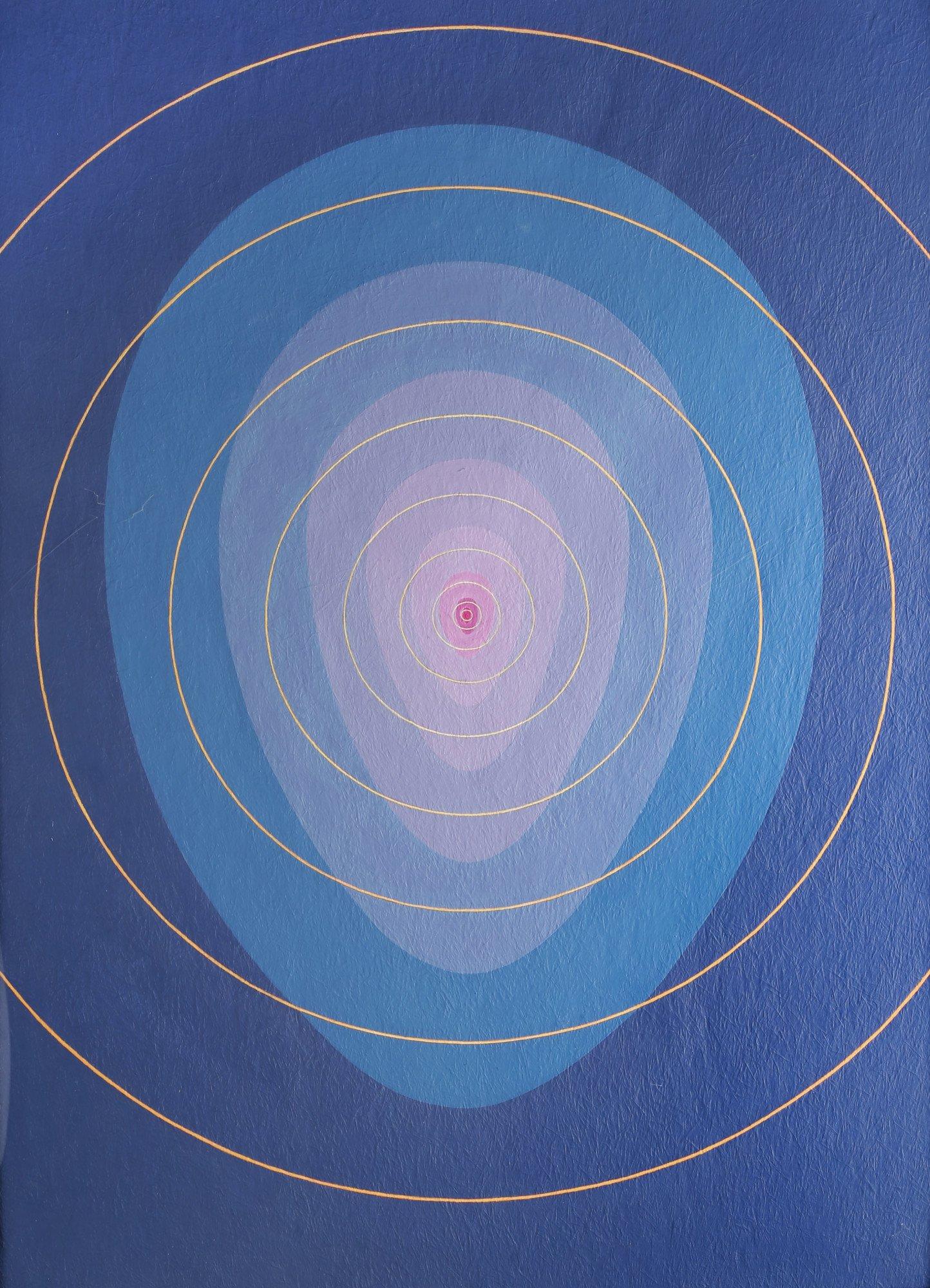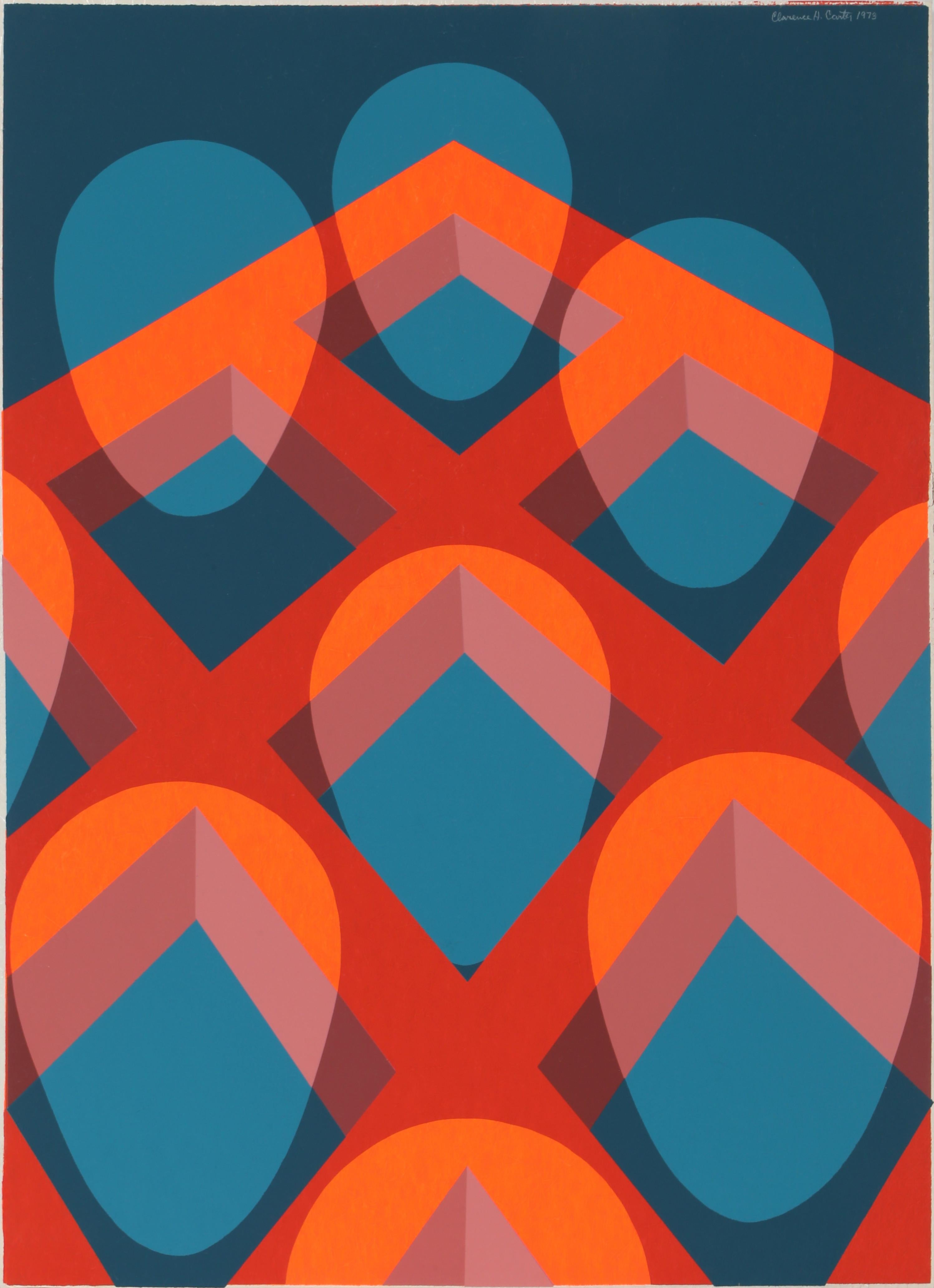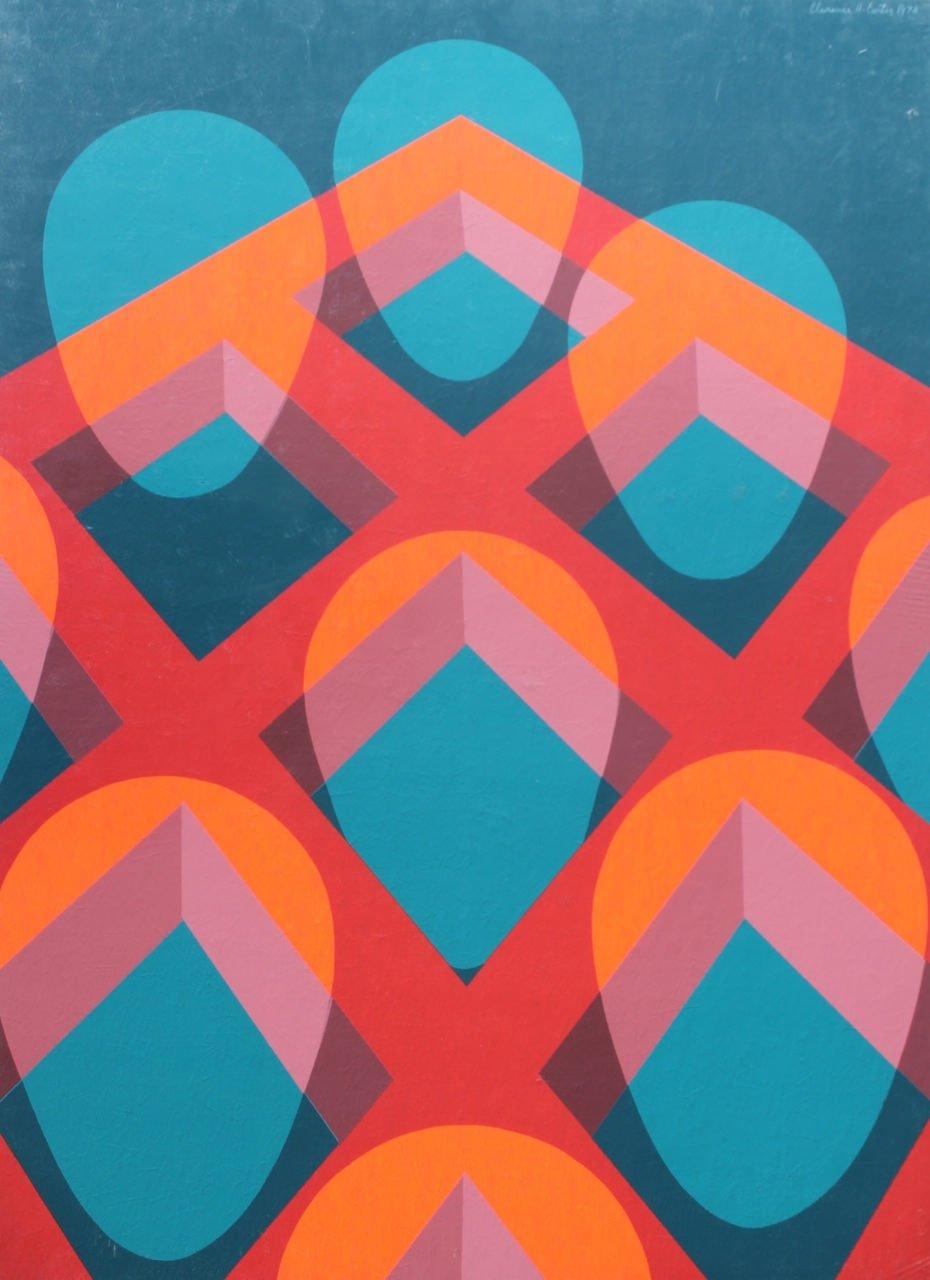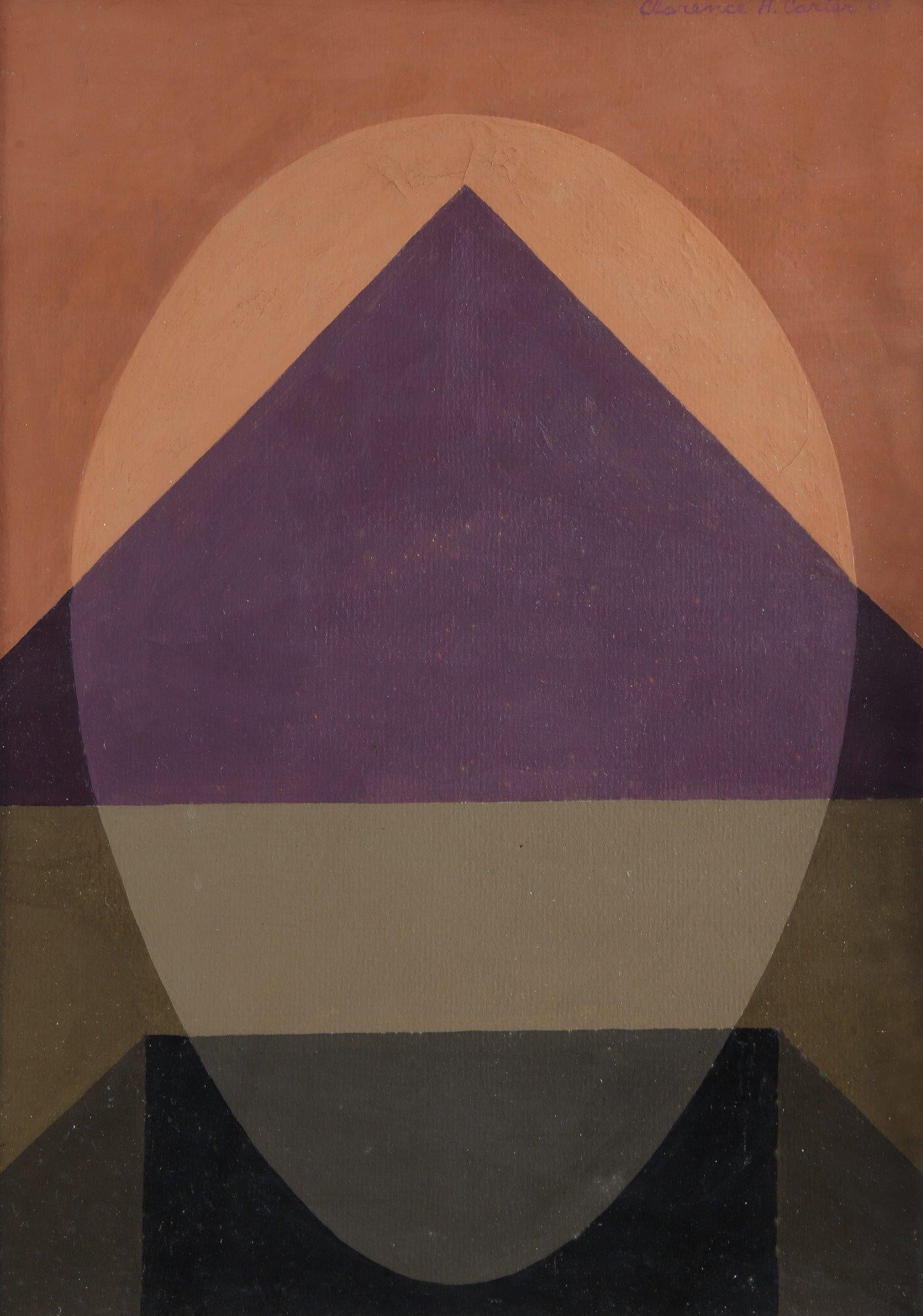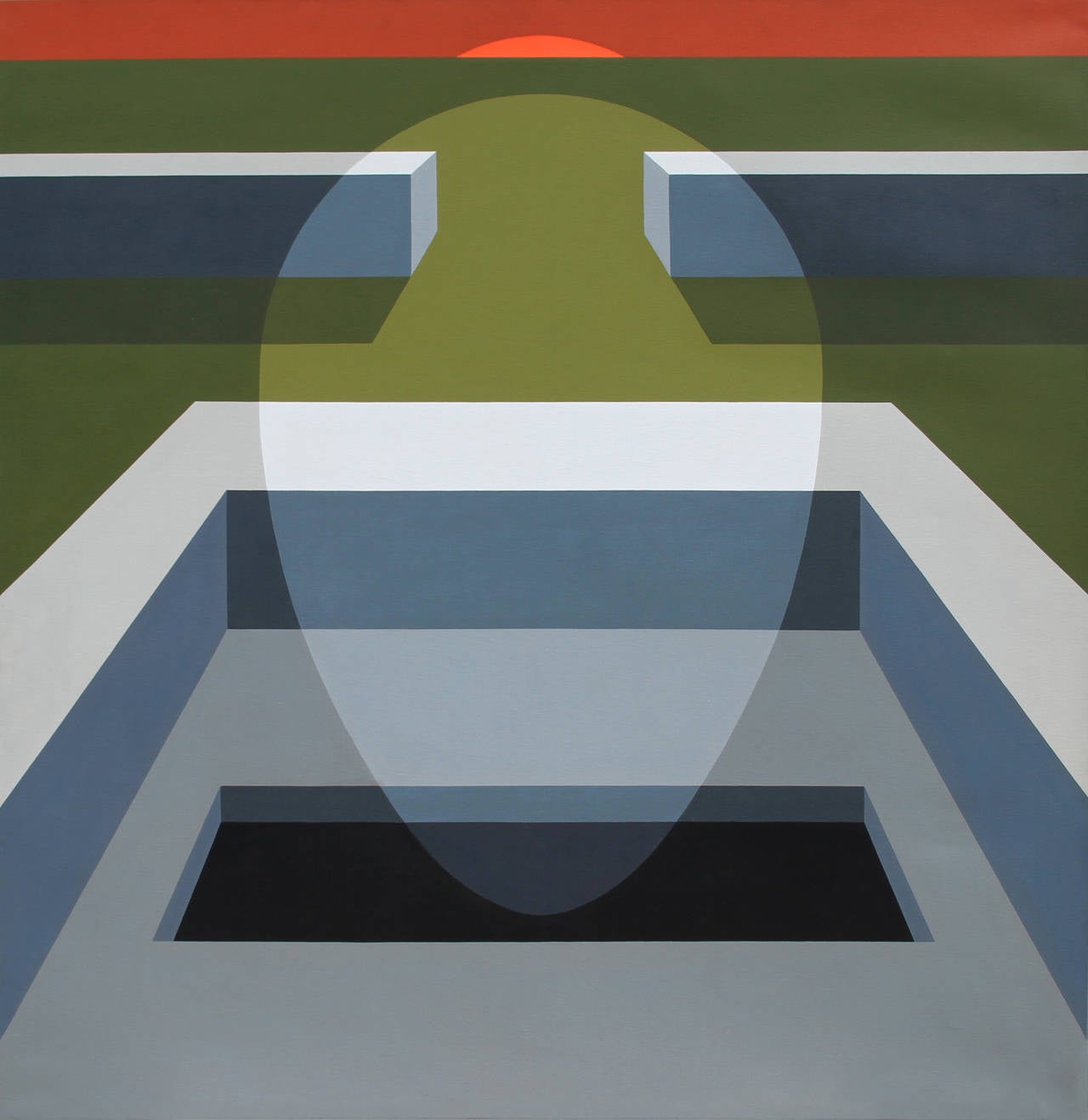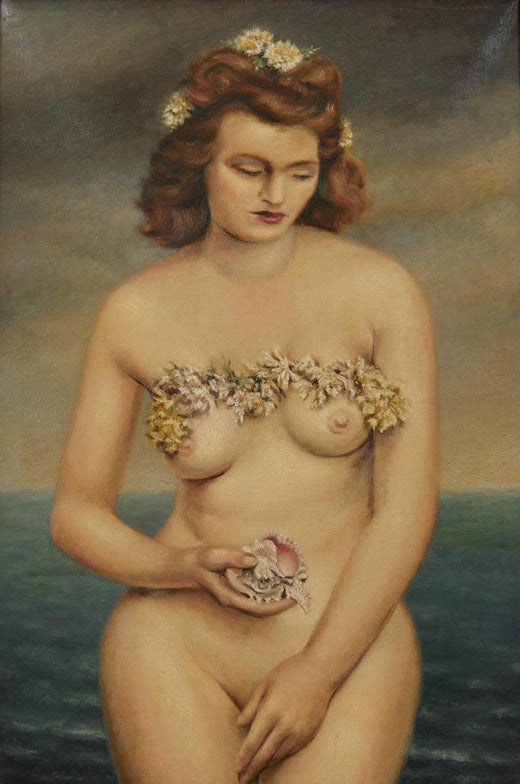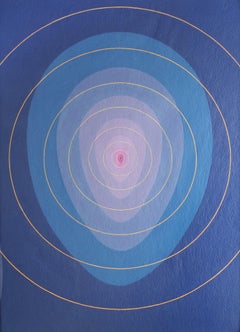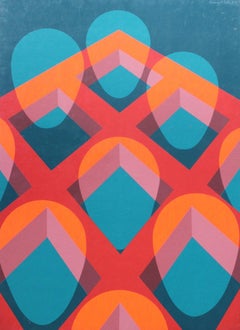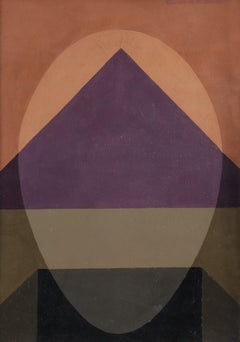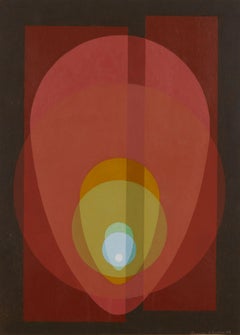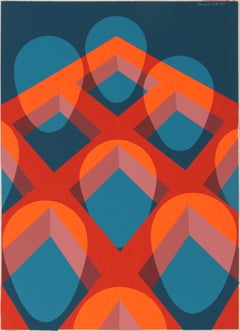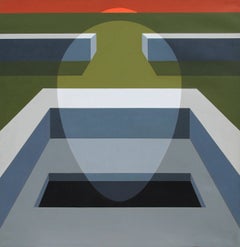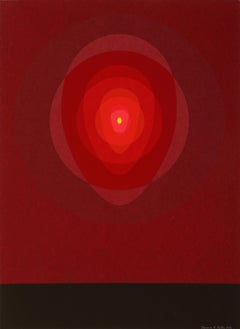Items Similar to Mandala No. 15, Abstract Ovoid Geometrical Mid-Century Painting Cleveland School
Want more images or videos?
Request additional images or videos from the seller
1 of 10
Clarence Holbrook CarterMandala No. 15, Abstract Ovoid Geometrical Mid-Century Painting Cleveland School1969
1969
$14,000
£10,611.20
€12,283.50
CA$19,764.36
A$22,009.19
CHF 11,491.50
MX$266,682.16
NOK 144,919.98
SEK 136,743.42
DKK 91,694.88
About the Item
Clarence Holbrook Carter (American, 1904-2000)
Mandala No. 15, 1969
Acrylic on paper
Signed and dated verso
27.5 x 22 inches
Clarence Holbrook Carter achieved a level of national artistic success that was nearly unprecedented among Cleveland School artists of his day, with representation by major New York dealers, scores of awards and solo exhibits, and streams of praise flowing from pens of the top art critics. Over the course of his 60+ year career Carter evolved from an exceptionally fine American Scene painter capable of evoking deep reservoirs of mood, into an abstractionist with a strongly surrealist bent.
While his two bodies of work seem at first to be worlds apart, owing to their different formal vocabularies, they, in fact, explore virtually the same subject: the nexus between life and death and the transition from earth to spirit. The early work finds its expressive power through specific people, events, and landscapes—most of which are drawn from his experiences growing up in the river town of Portsmouth, Ohio—while the later work from the 1960s on evokes potent states of being through pure flat shape, color and form that read as universals. As his primary form he adopted the ovoid or egg shape, endowing it with varying degrees of transparency. Alone or in multiples, the egg moves through Carter’s landscapes and architectural settings like a sentient spirit on a restless quest.
Born and raised in southern Ohio along the banks of the mercurial Ohio River and its treacherous floods, Carter developed a love of drawing as a child, and was encouraged by both his parents. He was self-directed, found inspiration all around him, and was strongly encouraged by the fact that his teenage work consistently captured art prizes in county and state fairs. Although money was tight after his father (who was a postal worker) died suddenly of a stroke, Carter’s mother supported his desire to study at the Cleveland School of Art from 1923-27, where he trained under painters Henry Keller, Frank Wilcox and Paul Travis.
In the summer of 1927, Carter studied in Capri with the modernist Hans Hofmann, where he carried out compositional exercises in charcoal and paint, recording the lucid spatial order of stairs, walls, roofs, arches and other elements of the island’s compressed architecture. Returning to Cleveland in 1929, Carter had his first solo show, and through Milliken taught studio classes at the Cleveland Museum of Art from 1930-37. In 1934, he worked under the auspices of the Public Works of Art Project and won a commission to paint two murals in Cleveland’s Public Auditorium. In 1936, he painted a post office mural in Ravenna, Ohio, as well as one for the post office in his hometown of Portsmouth, where his father had worked. He then headed the Northeast Ohio division of the painting projects arm of the Works Progress Administration, a subsequent government art program. In 1938, he moved to Pittsburgh to teach at the Carnegie Institute of Technology until 1944. Carter’s American Scene paintings of the ’30s and ’40s, which launched his artistic star, are the works for which the artist remains best known.
During and immediately after World War II, Clarence Carter realized his attraction to bold pattern, dramatic perspective and eye-catching hard-edged design was a poor fit with the prevailing style of Abstract Expressionism. Fortunately, these same hallmarks of his style were prized within the realm of commercial art. Thus, from 1944-1959, Carter became a veritable “Mad Man [Madison Avenue Man],” designing ambitious series of advertisements for major corporations such as Alcoa and The National City Bank of New York (Citibank) which appeared on the back covers of Fortune magazine, and on inside pages of Time, Newsweek, Business Week, and US News & World Report. Carter described this period of his life as one of incredible inventiveness and imagination. It freed him up to be far more experimental in his approach to image-making.
Around 1964 Carter acknowledged a need to break from the confines of representational painting. Once Carter had found a potent symbol in the egg, he used it to create an astounding body of imagery for the rest of his life. Among the most ambitious of all his later paintings were his Transections, a theological term meaning to cross, specifically between life and death.
- Creator:Clarence Holbrook Carter (1904-2000, American)
- Creation Year:1969
- Dimensions:Height: 27.5 in (69.85 cm)Width: 22 in (55.88 cm)
- Medium:
- Movement & Style:
- Period:
- Condition:
- Gallery Location:Beachwood, OH
- Reference Number:1stDibs: LU1768212972342
Clarence Holbrook Carter
Clarence Holbrook Carter achieved a level of national artistic success that was nearly unprecedented among Cleveland School artists of his day, with representation by major New York dealers, scores of awards and solo exhibits, and streams of praise flowing from pens of the top art critics. Over the course of his 60+ year career Carter evolved from an exceptionally fine American Scene painter capable of evoking deep reservoirs of mood, into an abstractionist with a strongly surrealist bent. While his two bodies of work seem at first to be worlds apart, owing to their different formal vocabularies, they, in fact, explore virtually the same subject: the nexus between life and death and the transition from earth to spirit. The early work finds its expressive power through specific people, events, and landscapes—most of which are drawn from his experiences growing up in the river town of Portsmouth, Ohio—while the later work from the 1960s on evokes potent states of being through pure flat shape, color and form that read as universals. As his primary form he adopted the ovoid or egg shape, endowing it with varying degrees of transparency. Alone or in multiples, the egg moves through Carter’s landscapes and architectural settings like a sentient spirit on a restless quest. Born and raised in southern Ohio along the banks of the mercurial Ohio River and its treacherous floods, Carter developed a love of drawing as a child, and was encouraged by both his parents. He was self-directed, found inspiration all around him, and was strongly encouraged by the fact that his teenage work consistently captured art prizes in county and state fairs. Carter studied at the Cleveland School of Art from 1923-27, where he trained under painters Henry Keller, Frank Wilcox and Paul Travis. Returning to Cleveland in 1929, Carter had his first solo show, and through Milliken taught studio classes at the Cleveland Museum of Art from 1930-37. In 1938, he moved to Pittsburgh to teach at the Carnegie Institute of Technology until 1944. Carter’s American Scene paintings of the ’30s and ’40s, which launched his artistic star, are the works for which the artist remains best known. During and immediately after World War II, Clarence Carter realized his attraction to bold pattern, dramatic perspective and eye-catching hard-edged design was a poor fit with the prevailing style of Abstract Expressionism. Fortunately, these same hallmarks of his style were prized within the realm of commercial art. Around 1964 Carter acknowledged a need to break from the confines of representational painting. Once Carter had found a potent symbol in the egg, he used it to create an astounding body of imagery for the rest of his life. Among the most ambitious of all his later paintings were his Transections, a theological term meaning to cross, specifically between life and death.
About the Seller
5.0
Platinum Seller
Premium sellers with a 4.7+ rating and 24-hour response times
Established in 1975
1stDibs seller since 2022
36 sales on 1stDibs
Typical response time: <1 hour
- ShippingRetrieving quote...Shipping from: Beachwood, OH
- Return Policy
Authenticity Guarantee
In the unlikely event there’s an issue with an item’s authenticity, contact us within 1 year for a full refund. DetailsMoney-Back Guarantee
If your item is not as described, is damaged in transit, or does not arrive, contact us within 7 days for a full refund. Details24-Hour Cancellation
You have a 24-hour grace period in which to reconsider your purchase, with no questions asked.Vetted Professional Sellers
Our world-class sellers must adhere to strict standards for service and quality, maintaining the integrity of our listings.Price-Match Guarantee
If you find that a seller listed the same item for a lower price elsewhere, we’ll match it.Trusted Global Delivery
Our best-in-class carrier network provides specialized shipping options worldwide, including custom delivery.More From This Seller
View AllMandala No. 5, Blue Abstract Ovoid Mid-Century Painting
By Clarence Holbrook Carter
Located in Beachwood, OH
Clarence Holbrook Carter (American, 1904-2000)
Mandala No. 5, 1968
Acrylic on scintilla
Signed on verso
29.5 x 22 inches
Clarence Holbrook Carter achieved a level of national artist...
Category
1960s Abstract Abstract Paintings
Materials
Acrylic
Transection No. 3, Ovoid Geometrical Figural Abstract Neon Acrylic Painting
By Clarence Holbrook Carter
Located in Beachwood, OH
Clarence Holbrook Carter (American, 1904-2000)
Transection No. 3, 1972
Acrylic on paper
Signed and dated upper right
30 x 22 inches
Provenance: Collection of William H. Milliken
Cl...
Category
1970s American Modern Abstract Paintings
Materials
Acrylic
King Tut No. 2, Mid-Century Ovoid Geometrical Abstract Gouache on Paper
By Clarence Holbrook Carter
Located in Beachwood, OH
Clarence Holbrook Carter (American, 1904-2000)
King Tut No. 2, 1968
Gouache on paper
Signed and dated upper right
11.25 x 8.25 inches
25.5 x 20.5 inches
A surrealist mid-century fig...
Category
1960s American Modern Abstract Paintings
Materials
Gouache
Rainbow Mandala, Mid Century Abstract Red and Yellow Acrylic Painting
By Clarence Holbrook Carter
Located in Beachwood, OH
Clarence Holbrook Carter (American, 1904-2000)
Rainbow Mandala, 1983
Acrylic on scintilla
Signed and dated lower right
30 x 22 inches
Clarence Holbrook Carter achieved a level of na...
Category
1980s Abstract Abstract Paintings
Materials
Acrylic
Reverberations, mid-century abstract surrealist black acrylic painting
By Clarence Holbrook Carter
Located in Beachwood, OH
Clarence Holbrook Carter (American, 1904-2000)
Reverberations, 1970
Acrylic on illustration board
Signed lower left
20 x 30 inches
Mid-century abstract surrealist black acrylic painting...
Category
1970s Surrealist Abstract Paintings
Materials
Acrylic
Torso No. 1, Mid-Century Figural Abstract Acrylic Painting
By Clarence Holbrook Carter
Located in Beachwood, OH
Clarence Holbrook Carter (American, 1904-2000)
Torso No. 1, 1967
Acrylic on paper
Signed and dated upper right
15 x10 inches
24 x 20 inches, framed
A mid-century figural abstract painting.
Clarence Holbrook Carter achieved a level of national artistic success that was nearly unprecedented among Cleveland School artists of his day, with representation by major New York dealers...
Category
1960s American Modern Abstract Paintings
Materials
Acrylic
You May Also Like
Mandalas, Surrealist Screenprint by Clarence Holbrook Carter 1973
By Clarence Holbrook Carter
Located in Long Island City, NY
Artist: Clarence Holbrook Carter, American (1904 - 2000)
Title: Untitled (Mandalas in a Grid)
Year: 1973
Medium: Screenprint on Scintilla paper, Signed and numbered in pencil
Edition...
Category
1970s Abstract Geometric Abstract Prints
Materials
Screen
Transection No. 7, Large Painting by Clarence Carter
By Clarence Holbrook Carter
Located in Long Island City, NY
Artist: Clarence Holbrook Carter, American (1904 - 1998)
Title: Transection No. 7
Year: 1970
Medium: Acrylic on Canvas, signed verso
Size: 77 in. x 75.5 in. (195.58 cm x 191.77 c...
Category
1970s Abstract Geometric Abstract Paintings
Materials
Oil
Brown Mandala, Silkscreen by Clarence Holbrook Carter
By Clarence Holbrook Carter
Located in Long Island City, NY
Artist: Clarence Holbrook Carter, American (1904 - 2000)
Title: Brown Mandala
Year: 1969
Medium: Silkscreen on Scintilla paper, signed and numbered in pencil
Edition: 75
Paper Size: ...
Category
1960s Op Art Abstract Prints
Materials
Screen
Red Mandala, OP Art Geometric Abstract Screenprint by Clarence Holbrook Carter
By Clarence Holbrook Carter
Located in Long Island City, NY
Artist: Clarence Holbrook Carter, American (1904 - 2000)
Title: Red Mandala
Year: 1969
Medium: Screenprint on Japon, Signed and numbered in pencil
Edition: 75
Paper Size: 30 in. x 22...
Category
1960s Op Art Abstract Prints
Materials
Screen
Green Mandala, Geometric Minimalist Screenprint by Clarence Holbrook Carter
By Clarence Holbrook Carter
Located in Long Island City, NY
Artist: Clarence Holbrook Carter, American (1904 - 2000)
Title: Green Mandala
Year: 1969
Medium: Screenprint on Scintilla paper, signed and numbered in pencil
Edition: 75
Paper Size:...
Category
1970s Abstract Abstract Prints
Materials
Screen
Faces in Grid (Red), Abstract Surrealist Screenprint by Clarence Holbrook Carter
By Clarence Holbrook Carter
Located in Long Island City, NY
Artist: Clarence Holbrook Carter, American (1904 - 2000)
Title: Untitled - Faces in a Grid (Red)
Year: 1971
Medium: Screenprint on Scintilla paper, Signed and numbered in pencil
Edit...
Category
1970s Abstract Geometric Abstract Prints
Materials
Screen
More Ways To Browse
Midcentury Modern Paintings
Mid Century Geometric Art
Abstract Expressionism Mid Century Painting
Star Wars Painting
Mandala Paintings
Vintage Fortune Magazines
1960s Hard Edge Painting
River Of No Return
Madison Avenue Art
Mid Century Hard Edge Painting
Capri Painting
Paintings Of Capri
Mad Magazine
Vintage Cross Pens
Clarence Wells
Mad Charcoal
French Painting Vertical
Hunting Light
